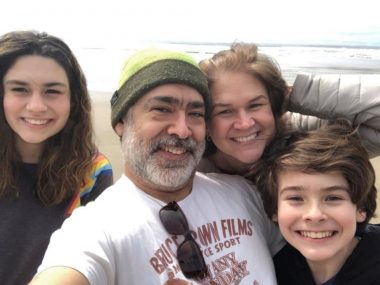Film Animator’s New Mission: Calling Attention to ‘Fabry Fog’

(Photo by Manop/Shutterstock)
Wes Burian had a dream job as an animated film surfacing supervisor, bringing to life lovable characters like Po from “Kung Fu Panda.” But Burian, now 48, has Fabry disease, and its progression — increasing exhaustion and the beginnings of cognitive impairment he calls Fabry fog — ultimately stopped his career in its tracks.
Burian had wanted to work in the movies ever since he saw “Star Wars” in theaters when he was 5 years old. He made that dream job a reality, going to work for DreamWorks Animation in June 2002 after working on movies such as “Men in Black II” and “Blade 2.”
At DreamWorks, he took on projects like “Shark Tale” and “Monsters vs. Aliens,” and then supervised surfacing artists on all three “Kung Fu Panda” movies. But between exhaustion and an increasing difficulty in learning new animation techniques and software, he was forced to retire and go on disability in March 2017.
“All of a sudden, I really had no purpose,” Burian said.

Wes Burian on a beach in Oregon. (Photos courtesy of Wes Burian)
Symptoms of Fabry disease, a genetic disorder, affect the whole body, and include chronic pain, hearing loss, kidney damage, a decreased ability to sweat, gastrointestinal problems, and brain lesions. Additionally, patients have a greater risk of stroke.
Researchers also are beginning to see signs of cognitive impairment — dubbed “Fabry fog” by advocates, including Burian — though it’s not usually listed as a symptom.
Now that enzyme replacement therapy (ERT) is part of the standard care regimen for the disease, men — who tend to have worse symptoms — are starting to live longer. According to Burian, who has been on ERT since June 2003, that gives “Fabry fog” a chance to subtly creep up. But he isn’t the only one noticing trends in his life that increasingly make no sense.
One 2018 review study showed that about half of patients diagnosed with Fabry disease have lesions in the brain. These lesions were found in the white matter, which is responsible for transmitting nerve signals and communication between different parts of the brain.
A more recent article looked at the differences between white matter volume in 31 Fabry patients and 19 healthy people used as controls, as measured by fractional anisotropy, a neuroimaging technique to capture white matter integrity. The results showed Fabry patients had a lower value (0.423) than did controls (0.446), with lower numbers indicating a lesser volume and more white matter damage.
What’s more, the researchers wrote, “average white matter fractional anisotropy and white matter lesion volume showed statistically significant correlations with Digit Symbol Coding Test score,” considered a measure of a patient’s cognitive abilities.
Hit by a ‘ton of bricks’
Exhaustion was the primary reason Burian had to quit his job. He would sometimes sleep in his office and go home early, handing off his responsibilities to another manager.
After his retirement, Burian moved north from Glendale, California, to a small suburb outside of Portland, Oregon, uprooting his family for a colder climate that better suited his inability to sweat. That inability to sweat is a key symptom of his type 1, or classic, Fabry disease.
Fabry prevents the body from making an enzyme, alpha-galactosidase A, that’s responsible for breaking down a type of fat. People with type 1 Fabry have little to no functional alpha-galactosidase A, which causes lipid wastes to accumulate in their small blood vessels.
“It seemed like a good place where I could breathe and figure out the rest of my life,” said Burian, who had grown up in Vancouver, British Columbia, and liked Oregon’s cooler temperatures.
But over the past two years, Burian said, his “Fabry fog” has morphed into a big and daily problem. Burian said his executive functioning is now lacking, and remembering words or to-do lists is difficult. Moreover, completing complex projects which once were possible — like rewiring his daughter’s Toyota Prius — are now almost impossible. He quit motorcycling, a hobby that had put him in “a state of flow and strength,” because his body too often let him down.
“It’s not just that I’m a 40-year-old guy and sometimes I can’t find the car keys,” Burian said. “It messes with your identity.”
His wife has to remind him of things he’s forgotten to do, like moving a tub of Legos his niece was playing with to storage. She never would have had to do that a couple of years earlier, Burian said.
Then there’s his habit of sending out postcards to friends across the country, part of his goal to “share beauty and love with people.” He’ll be distracted by something, he said, and come back five days later, realizing he hadn’t yet sent them out.
What frustrates him most is the inability to find the exact word to describe something when he’s speaking. He used to read a lot and have a large vocabulary, he said. Now things have changed, and Burian feels embarrassed about it.
“It’s really started to hit me like a ton of bricks,” Burian said.
A new purpose
In trying to re-establish his purpose in life, Burian has focused, in part, on bringing awareness to this lesser-known symptom of Fabry.
“Even the name ‘Fabry fog’ is very undefined as to what it is,” Burian said. “But it’s undeniable when you talk to groups of patients.”

Burian and his family. His daughter also has Fabry disease.
He’s trying to get doctors, researchers, and the biotech industry to take a closer look at failures of the brain as well as the kidneys, which Burian sees as the “low-hanging fruit.” Throughout his disease journey, Burian has learned to be his own advocate, and sharing his story, he said, is one of the best ways to do that.
“At the end of the day when you lie down in bed, you’re the one who feels the pain and has to deal with having everything still in your body,” he said.
His 16-year-old daughter, who also has Fabry disease, plays a large role in inspiring him to get his story out. She began ERT in December.
Burian believes that a gene therapy capable of crossing the blood-brain barrier might be the most promising way to stabilize so-called Fabry fog. He’s investigating current gene therapy trials but has not enrolled in one.
There are several in the pipeline, all aiming to restore the missing enzyme, alpha-galactosidase A, though not all apply to Burian.
Avrobio is conducting a Phase 1/2 trial (NCT03454893) in ERT-naive patients — people who have not yet had this type of therapy — to assess the safety and effectiveness of AVR-RD-01. This experimental gene therapy delivers the healthy form of the GLA gene, which is mutated in Fabry, to a patient’s stem cells.
Additionally, Sangamo Therapeutics’ gene therapy ST-920, delivered via an adeno-associated viral vector, or AAV — a virus engineered to be harmless — is in a Phase 1/2 trial (NCT04046224) in the U.S. and the U.K. that is still recruiting.
Freeline’s liver-directed gene therapy FLT190, which also uses an AAV as a transport agent, is actively recruiting both treatment naive and ERT users for its Phase 1/2 trial (NCT04040049), taking place in Europe. And 4D Molecular Therapeutics is enrolling adults, including those on stable ERT use, for its AAV gene therapy — 4D-310 — in a dose-escalation Phase 1/2 trial (NCT04519749) at sites across the U.S.
Burian hopes his plan to participate in a trial might lead to a therapy’s approval, so younger patients — those in his daughter’s generation — won’t have to rely on ERT for their entire life.
“It’s all for my daughter when it really boils down to it. I’d be pretty happy to go live in the forest, but I’m out here trying to ask questions in patient forums to further research for her,” Burian said. “It’s hard to see the pain that I’ve known in my own body starting to present itself in her body.”
Across the Fabry community, Burian spoke of seeing stories of invalidation, of patients whose “Fabry fog” concerns aren’t being heard by their doctors. He believes the more research that goes into this symptom, the better tools that physicians will have to address its underlying issues. But it all comes back to getting the word out, which takes advocacy and action.
Burian ultimately hopes he can share something, like Po in “Kung Fu Panda,” with the rest of the Fabry community.
“If I can bring unexpected joy to one person or comfort someone’s experience with this disease, then I feel like that’s what I’m here to do now,” he said.






